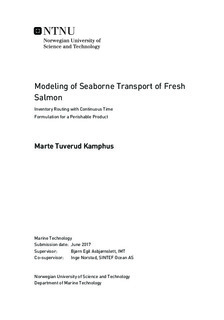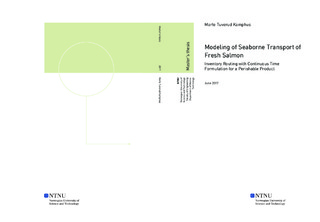| dc.description.abstract | Norway produced 1,31 million tonnes of farmed salmon in 2015, and the production is expected to grow to 5 million tonnes in 2050. Every day, around 120 semi-trailers are on the roads, just with the mission of transporting fresh salmon from Norway to markets in Europe. The road network has an overall high load and the fish transport generates a big share. To handle future growth in the seafood industry it is therefore important to come up with new sustainable transportation solutions.
This report presents seaborne transportation of fresh salmon from Norway to Europe as a solution to future growth in the seafood industry. The aim of this thesis is to look at seaborne transportation and utilize optimization to build a mathematical model that transports salmon between loading and unloading ports, and to get insight and knowledge about the problem.
Transportation of seafood with semi-trailers are well utilized and the salmon gets fast to different markets. It will take a longer time to slaughter the salmon to fill up a ship, than filling up a semi-trailer. Fresh salmon is a perishable item and the durability is extremely important. The product degrades fast and it is important to track the time from the salmon first was slaughtered, to know exactly how old it is when it is delivered.
The biggest slaughter facilities in Norway often slaughter the salmon in three shifts per day. The production rate of salmon, that is assumed to be transported with ships, is therefore assumed to be constant per hour. The problem presented in this thesis is modeled as an Inventory Routing Problem, which enables the planners to evaluate both the inventory levels and the routing decisions. The mathematical model developed is a mixed integer model. Perishable considerations are included in the model to track the lead time and avoid waste of the product. To the authors knowledge perishability of items has never been explicitly modeled in maritime inventory routing problems before.
The mathematical model is implemented in the commercial software FICO(TM) Xpress Optimization Suit. It is tested on a case study for different combinations of loading and unloading ports. Result for one loading port and one unloading port with a production rate of 35 tonnes of salmon per hour gives a maximum lead time of 128 hours throughout the whole planning horizon. The problem is solved to optimality, and two ships are necessary in the solution. Increasing the production rate to 50 tonnes per hour, a solution with 10.7\% optimality gap is obtained, and the model was stopped after 14 hours. The maximum lead time is decreased to 106.5 hours, but three vessels are necessary. The computational study for two ports shows that number of vessels necessary to keep the inventories satisfied and minimizing the lead time and cost are dependent on the production rate. The model has been tested with three ports as well, but few solutions have been obtained. A lot of time has been used on building a model with perishable considerations, and due to a developed model with high complexity fewer solutions than planned for have been obtained.
However, the model developed presents a new type of model that considers maritime inventory routing of a perishable asset. Tighter formulations are necessary for the model to solve the problem, but the model can be considered as a starting base for becoming a decision tool for the fish transportation in the future. | |

